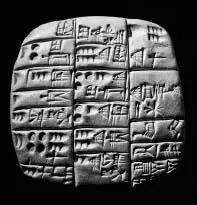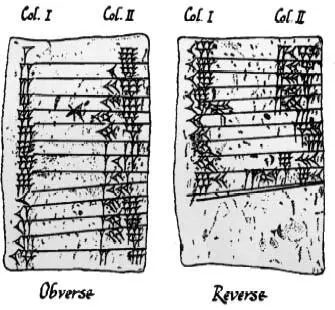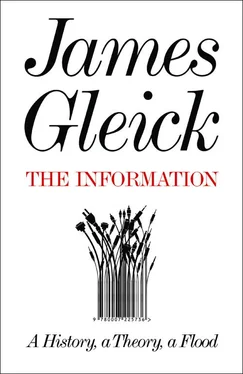1 ...8 9 10 12 13 14 ...33 Two millennia later, philosophers continue to struggle with these texts. The paths of logic into modern thought are roundabout, broken, and complex. Since the paradoxes seem to be in language, or about language, one way to banish them was to purify the medium: eliminate ambiguous words and woolly syntax, employ symbols that were rigorous and pure. To turn, that is, to mathematics. By the beginning of the twentieth century, it seemed that only a system of purpose-built symbols could make logic work properly—free of error and paradoxes. This dream was to prove illusory; the paradoxes would creep back in, but no one could hope to understand until the paths of logic and mathematics converged.
Mathematics, too, followed from the invention of writing. Greece is often thought of as the springhead for the river that becomes modern mathematics, with all its many tributaries down the centuries. But the Greeks themselves alluded to another tradition—to them, ancient— which they called Chaldean, and which we understand to be Babylonian. That tradition vanished into the sands, not to surface until the end of the nineteenth century, when tablets of clay were dug up from the mounds of lost cities.
First there were scores, then thousands of tablets, typically the size of a human hand, etched with a distinctive, edgy, angular writing called cuneiform, “wedge shaped.” Mature cuneiform was neither pictographic (the symbols were spare and abstract) nor alphabetic (they were far too numerous). By 3000 BCE a system with about seven hundred symbols flourished in Uruk, the walled city, probably the largest in the world, home of the hero-king Gilgamesh, in the alluvial marshes near the Euphrates River. German archeologists excavated Uruk in a series of digs all through the twentieth century. The materials for this most ancient of information technologies lay readily at hand. With damp clay held in one hand and a stylus of sharpened reed in the other, a scribe would imprint tiny characters in columns and rows.

A CUNEIFORM TABLET
The result: cryptic messages from an alien culture. They took generations to decipher. “Writing, like a theater curtain going up on these dazzling civilizations, lets us stare directly but imperfectly at them,” writes the psychologist Julian Jaynes. Some Europeans took umbrage at first. “To the Assyrians, the Chaldeans, and Egyptians,” wrote the seventeenth-century divine Thomas Sprat, “we owe the Invention” but also the “Corruption of knowledge,” when they concealed it with their strange scripts. “It was the custom of their Wise men, to wrap up their Observations on Nature, and the Manners of Men, in the dark Shadows of Hieroglyphicks ” (as though friendlier ancients would have used an alphabet more familiar to Sprat). The earliest examples of cuneiform baffled archeologists and paleolinguists the longest, because the first language to be written, Sumerian, left no other traces in culture or speech. Sumerian turned out to be a linguistic rarity, an isolate, with no known descendants. When scholars did learn to read the Uruk tablets, they found them to be, in their way, humdrum: civic memoranda, contracts and laws, and receipts and bills for barley, livestock, oil, reed mats, and pottery. Nothing like poetry or literature appeared in cuneiform for hundreds of years to come. The tablets were the quotidiana of nascent commerce and bureaucracy. The tablets not only recorded the commerce and the bureaucracy but, in the first place, made them possible.
Even then, cuneiform incorporated signs for counting and measurement. Different characters, used in different ways, could denote numbers and weights. A more systematic approach to the writing of numbers did not take shape until the time of Hammurabi, 1750 BCE, when Mesopotamia was unified around the great city of Babylon. Hammurabi himself was probably the first literate king, writing his own cuneiform rather than depending on scribes, and his empire building manifested the connection between writing and social control. “This process of conquest and influence is made possible by letters and tablets and stelae in an abundance that had never been known before,” Jaynes declares. “Writing was a new method of civil direction, indeed the model that begins our own memo-communicating government.”
The writing of numbers had evolved into an elaborate system. Numerals were composed of just two basic parts, a vertical wedge for 1 (  ) and an angle wedge for 10 (
) and an angle wedge for 10 (  ). These were combined to form the standard characters, so that represented 3 and represented 16, and so on. But the Babylonian system was not decimal, base 10; it was sexagesimal, base 60. Each of the numerals from 1 to 60 had its own character. To form large numbers, the Babylonians used numerals in places:
). These were combined to form the standard characters, so that represented 3 and represented 16, and so on. But the Babylonian system was not decimal, base 10; it was sexagesimal, base 60. Each of the numerals from 1 to 60 had its own character. To form large numbers, the Babylonians used numerals in places:  was 70 (one 60 plus ten 1s);
was 70 (one 60 plus ten 1s);  was 616 (ten 60s plus sixteen 1s), and so on. None of this was clear when the tablets first began to surface. A basic theme with variations, encountered many times, proved to be multiplication tables. In a sexagesimal system these had to cover the numbers from 1 to 19 as well as 20, 30, 40, and 50. Even more difficult to unravel were tables of reciprocals, making possible division and fractional numbers: in the 60-based system, reciprocals were 2:30, 3:20, 4:15, 5:12 . . . and then, using extra places, 8:7,30, 9:6,40, and so on. 1
was 616 (ten 60s plus sixteen 1s), and so on. None of this was clear when the tablets first began to surface. A basic theme with variations, encountered many times, proved to be multiplication tables. In a sexagesimal system these had to cover the numbers from 1 to 19 as well as 20, 30, 40, and 50. Even more difficult to unravel were tables of reciprocals, making possible division and fractional numbers: in the 60-based system, reciprocals were 2:30, 3:20, 4:15, 5:12 . . . and then, using extra places, 8:7,30, 9:6,40, and so on. 1

A MATHEMATICAL TABLE ON A CUNEIFORM TABLETANALYZED BY ASGER AABOE
These symbols were hardly words—or they were words of a peculiar, slender, rigid sort. They seemed to arrange themselves into visible patterns in the clay, repetitious, almost artistic, not like any prose or poetry archeologists had encountered. They were like maps of a mysterious city. This was the key to deciphering them, finally: the ordered chaos that seems to guarantee the presence of meaning. It seemed like a task for mathematicians, anyway, and finally it was. They recognized geometric progressions, tables of powers, and even instructions for computing square roots and cube roots. Familiar as they were with the rise of mathematics a millennium later in ancient Greece, these scholars were astounded at the breadth and depth of mathematical knowledge that existed before in Mesopotamia. “It was assumed that the Babylonians had had some sort of number mysticism or numerology,” wrote Asger Aaboe in 1963, “but we now know how far short of the truth this assumption was.” The Babylonians computed linear equations, quadratic equations, and Pythagorean numbers long before Pythagoras. In contrast to the Greek mathematics that followed, Babylonian mathematics did not emphasize geometry, except for practical problems; the Babylonians calculated areas and perimeters but did not prove theorems. Yet they could (in effect) reduce elaborate second-degree polynomials. Their mathematics seemed to value computational power above all.
That could not be appreciated until computational power began to mean something. By the time modern mathematicians turned their attention to Babylon, many important tablets had already been destroyed or scattered. Fragments retrieved from Uruk before 1914, for example, were dispersed to Berlin, Paris, and Chicago and only fifty years later were discovered to hold the beginning methods of astronomy. To demonstrate this, Otto Neugebauer, the leading twentieth-century historian of ancient mathematics, had to reassemble tablets whose fragments had made their way to opposite sides of the Atlantic Ocean. In 1949, when the number of cuneiform tablets housed in museums reached (at his rough guess) a half million, Neugebauer lamented, “Our task can therefore properly be compared with restoring the history of mathematics from a few torn pages which have accidentally survived the destruction of a great library.”
Читать дальше


 ) and an angle wedge for 10 (
) and an angle wedge for 10 (  ). These were combined to form the standard characters, so that represented 3 and represented 16, and so on. But the Babylonian system was not decimal, base 10; it was sexagesimal, base 60. Each of the numerals from 1 to 60 had its own character. To form large numbers, the Babylonians used numerals in places:
). These were combined to form the standard characters, so that represented 3 and represented 16, and so on. But the Babylonian system was not decimal, base 10; it was sexagesimal, base 60. Each of the numerals from 1 to 60 had its own character. To form large numbers, the Babylonians used numerals in places:  was 616 (ten 60s plus sixteen 1s), and so on. None of this was clear when the tablets first began to surface. A basic theme with variations, encountered many times, proved to be multiplication tables. In a sexagesimal system these had to cover the numbers from 1 to 19 as well as 20, 30, 40, and 50. Even more difficult to unravel were tables of reciprocals, making possible division and fractional numbers: in the 60-based system, reciprocals were 2:30, 3:20, 4:15, 5:12 . . . and then, using extra places, 8:7,30, 9:6,40, and so on. 1
was 616 (ten 60s plus sixteen 1s), and so on. None of this was clear when the tablets first began to surface. A basic theme with variations, encountered many times, proved to be multiplication tables. In a sexagesimal system these had to cover the numbers from 1 to 19 as well as 20, 30, 40, and 50. Even more difficult to unravel were tables of reciprocals, making possible division and fractional numbers: in the 60-based system, reciprocals were 2:30, 3:20, 4:15, 5:12 . . . and then, using extra places, 8:7,30, 9:6,40, and so on. 1










